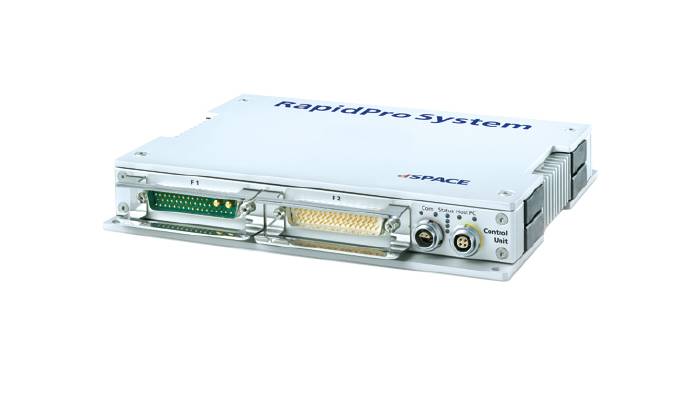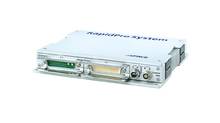RapidPro Control Unit
Intelligent I/O subsystem for dSPACE prototyping systems
The MPC565-based RapidPro Control Unit can be used as an intelligent I/O subunit to provide existing prototyping systems – such as MicroAutoBox II – with additional I/O functionality.
- Complex I/O signal generation, acquisition and conditioning (up to 6 modules)
- USB configuration and LVDS slave communication interfaces
- Powerful FPGA
Application Areas
In applications such as engine or vehicle dynamics control, complex I/O tasks can be shifted from the prototyping system to the RapidPro Control Unit. The RapidPro Control Unit also provides space for signal conditioning modules, so that different sensors can be adapted to a specific prototyping system.
Key Benefits
The MPC565-based RapidPro Control Unit is based on the same architecture as the RapidPro SC Unit. Additionally, the RapidPro Control Unit is equipped with a powerful microcontroller module, including an MPC565 microcontroller, which is dedicated to handling complex I/O tasks. The carrier board provides space for up to six signal conditioning modules (SC modules) and two communication (COM) modules. The signal conditioning modules are the same modules as for the SC Unit. The USB configuration interface module is used for communication with the host PC. The LVDS slave interface module enables high-speed communication with dSPACE prototyping systems (MicroAutoBox II). The RapidPro Control Unit can be used separately or in combination with the other units to build an intelligent I/O subsystem tailored to a particular application. An integrated Unit Connection Bus lets you connect several RapidPro SC or Power Units directly to the Control Unit without external wiring. Efficient configuration and diagnostics handling of a single control unit or a stack are provided by ConfigurationDesk. For graphical I/O integration and configuration, the RTI RapidPro Control Unit Blockset is available. This blockset provides extensive standard I/O functionalities such as PWM, bit I/O, A/D and special functionalities for engine, chassis and drives control. Additional interactive diagnostics with feedback to the model can be performed.
| Parameter | Specification | ||
|---|---|---|---|
| General |
|
||
| Microcontroller module |
|
||
| Software support | Configuration |
|
|
| Diagnostics |
|
||
| I/O Real-Time Interface |
|
||
| Electrical characteristics | Power supply |
|
|
| Mechanical characteristics | Enclosure |
|
|
| Physical size (with cover and base plate) |
|
||
| Physical size (without cover and base plate) |
|
||
| Environmental characteristics | Ambient temperature |
|
|
| Vibration resistance1) |
EN 60068-2-6 |
|
|
|
ISO 16750-3:2007 / 4.1.2.4 Test IV |
|
||
| Shock resistance1) |
EN 60068-2-27 |
|
|
|
ISO 16750-3:2007 / 4.2.2 |
|
||
1) For more detailed information about test conditions and tested variants, please inquire.
-
- View online
- Download
Drive innovation forward. Always on the pulse of technology development.
Subscribe to our expert knowledge. Learn from our successful project examples. Keep up to date on simulation and validation. Subscribe to/manage dSPACE direct and aerospace & defense now.


